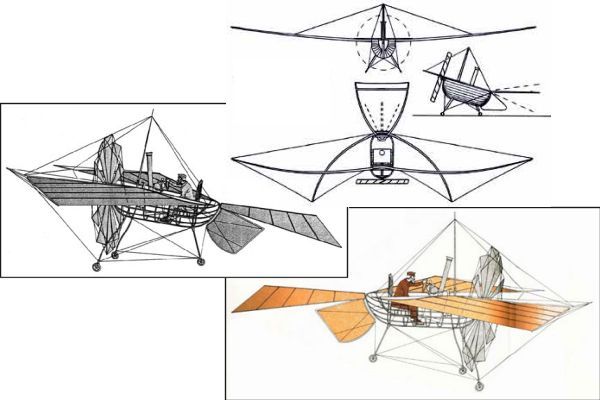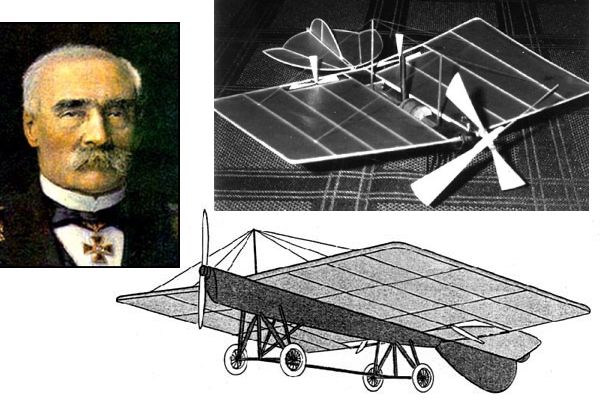|
||||||||||
|
|
||||||||||
|
||||||||||
|
|
||||||||||
Félix du Temple (1823-1890) was an officer in the French navy who was active in the new field of aeronautics from the 1850s to the 1870s. He is best known for two attempts at powered flight. The first of these was an unmanned monoplane powered by a single steam engine driving a tractor propeller. Before constructing his plane, du Temple built several models based on birds and concluded that the best design would use dihedral to increase stability. He also swept the wings forward to shift the vehicle's weight as far forward as possible and increase the effectiveness of the aft-mounted elevator and rudder surfaces. His design also featured a three-wheel retractable landing gear and a steam engine mounted inside a hull-shaped fuselage. The entire vehicle was around 24 ft (7.3 m) long with a span of 55 ft (16.8 m). The craft was launched down a hill and succeeded in making a short hop in 1857.

Urged on by this success, Félix and his brother Louis proceeded to construct a new version of the same design that was capable of carrying a pilot. Although the same overall shape was retained for the new aircraft, the du Temple brothers were unable to find a steam engine light enough and powerful enough to propel the vehicle. The two then decided to build their own "hot air" steam engine that was patented in 1867. Having solved the propulsion issue, the brothers continued their work and completed the new aircraft in 1874. The fuselage, based on the shape of a boat hull, consisted of an internal frame of wood or iron covered over by cloth. Similarly, the monoplane wing was constructed using curved spars of wood or metal and covered by stretched silk fabric. Both the wings and steam engine were attached to the central hull where the pilot was seated. The engine drove a single large propeller with a large number of blades. Félix also designed a control system consisting of both horizontal and vertical tails. The horizontal tail was hinged at the point it attached to the hull such that it could be used as an elevator to control pitch. A smaller and separate vertical tail was located underneath the elevator and served as a rudder to turn right and left. The completed plane had a wingspan of about 40 ft (12 m) and weighed around 160 lb (72.5 kg) empty.

No eyewitness accounts of this plane's attempts at flight have survived, but some sources indicate that a French sailor volunteered to fly the vehicle in 1874. It is said the craft managed to make a brief hop a few feet off the ground after being rolled down an inclined slope, gliding a short distance, and landing safely. If this account is true, Félix du Temple did succeed in launching the first manned, powered, fixed-wing, heavier-than-air flight, but the propulsion system was too weak to sustain the flight and the control system was ineffective. The du Temple brothers apparently lost interest in the project since there are no indications that any further flights were made. A fellow French aviation enthusiast of the day named Tissandier was later quoted as saying, "not withstanding most persevering efforts, no practical results could be obtained in experimenting with this apparatus."
Russian aviation pioneer Alexander Mozhaisky (1825-1890), also possibly spelled Mozhaiski or Mozhaiskii, was born in what is now Finland and spent much of his life serving in the Russian navy. I could find no evidence that he flew during the 1860s, but he did cultivate an interest in aeronautics during that decade. He began his efforts by studying birds, the structure of their wings, and the relationship between the area of their wings and their weight. Mozhaisky also studied kites as well as propellers during these early years. In order to further his work, Mozhaisky was able to receive some government funding from the Military Ministry for his research. Unfortunately, the government chose to discontinue its support in 1878, and Mozhaisky was forced to forge ahead on his own. He succeeded in designing an aircraft and received a patent on his invention in 1881.

Mozhaisky's design was well thought out and included the basic features we see on modern aircraft. The plane included a monoplane wing attached to a fuselage, a tail assembly for pitch and yaw control, two steam-powered engines, and a wheeled undercarriage. Construction began in 1881 after Mozhaisky was able to obtain a government grant to purchase a 10 hp and two 20 hp steam engines. The aircraft was equipped with a single 20 hp steam engine powering a tractor propeller at the nose of the fuselage and a 10 hp steam engine driving two pusher propellers that were mounted either near the wing trailing edge or around the middle of the craft. Overall, the plane was about 46 ft (14 m) in length with a wingspan of 74 ft (22.5 m).
It is believed that construction of the plane was completed in 1882, but no detailed records of its first flight have ever been found. The best information available seems to suggest that the plane made its only flight attempt in 1884 at Krasnoye Selo, near St. Petersburg. The craft was unable to take off from level ground, but reports indicate that it was launched using an inclined downhill ramp to become airborne. Accounts of the flight's success are conflicting. Early reports from the late 1800s and early 1900s indicate that the plane almost immediately tipped over onto one wing and crashed shortly after lift off. More recent accounts indicate that the plane may have made a short hop some 65 to 100 ft (19.8 to 30.5 m) in distance before it crashed to the ground. However, it should be noted that these more ambitious claims of success were not made until 1949 when the nationalistic Soviet leader Joseph Stalin asserted that Mozhaisky was the true inventor of the airplane.
In any event, both du Temple's and Mozhaisky's attempts were yet two more milestones on the path to making the
powered aircraft possible. Both may have succeeded in making a powered airplane become airborne briefly, but both
craft lacked sufficient power and adequate control. For these reasons, the flights were not sustainable or
repeatable. Nonetheless, it is clear that Félix du Temple and Alexander Mozhaisky were forward-thinking aviation
pioneers who understood many of the key design characteristics that were necessary to make a practical
heavier-than-air flying vehicle.
- answer by Jeff Scott, 18 April 2004
Related Topics:
What are the most significant events in the history of aviation and space flight?
Read More Articles:


|
Aircraft | Design | Ask Us | Shop | Search |

|
|
| About Us | Contact Us | Copyright © 1997- | |||
|
|
|||